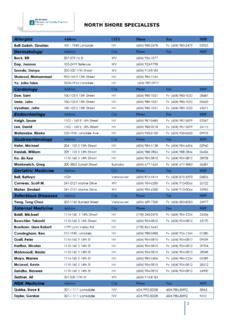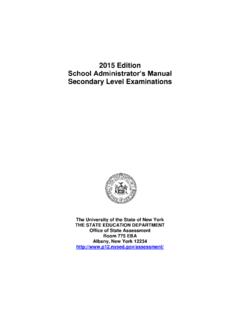Transcription of Atmel SAM D09 - Microchip Technology
1 Atmel -42414G-SAM-D09-Datasheet_09/2016 SMARTD escriptionThe Atmel | SMART sam d09 is a series of low-power microcontrollers using the 32-bit ARM Cortex -M0+ processor, and ranging from 14- to 24-pins with up to16KB Flash and 4KB of SRAM. The sam d09 devices operate at a maximum frequency of 48 MHz and reach Coremark/MHz. They are designed for simple and intuitive migration with identical peripheral modules, hex compatible code, identical linear address map and pin compatible migration paths between all devices in the product series. All devices include intelligent and flexible peripherals, Atmel Event System for inter-peripheral signaling, and support for capacitive touch button, slider and wheel user interfaces. The sam d09 series is compatible to the other product series in the SAM D family, enabling easy migration to larger device with added Atmel sam d09 devices provide the following features: In-system programmable Flash, six-channel direct memory access (DMA) controller, 6 channel Event System, programmable interrupt controller, up to 22 programmable I/O pins, 32-bit real-time clock and calendar, two 16-bit Timer/Counters (TC), where each TC can be configured to perform frequency and waveform generation, accurate program execution timing or input capture with time and frequency measurement of digital signals.
2 The TCs can operate in 8- or 16-bit mode, selected TCs can be cascaded to form a 32-bit TC, and one timer/counter has extended functions optimized for motor, lighting and other control applications. The series provide two Serial Communication Modules (SERCOM) that each can be configured to act as an USART, UART, SPI, I2C, SMBus, PMBus and LIN slave; up to 10-channel 350ksps 12-bit ADC with programmable gain and optional oversampling and decimation supporting up to 16-bit resolution, programmable Watchdog Timer, brown-out detector and power-on reset and two-pin Serial Wire Debug (SWD) program and debug devices have accurate and low-power external and internal oscillators. All oscillators can be used as a source for the system clock. Different clock domains can be independently configured to run at different frequencies, enabling power saving by running each peripheral at its optimal clock frequency, and thus maintaining a high CPU frequency while reducing power sam d09 devices have two software-selectable sleep modes, idle and standby.
3 In idle mode the CPU is stopped while all other functions can be kept running. In standby all clocks and functions are stopped expect those selected to continue running. The device supports SleepWalking. This feature allows the peripheral to wake up from sleep based on predefined conditions, and thus allows the CPU to wake up only when needed, when a threshold is crossed or a result is ready. The Event System supports synchronous and asynchronous events, allowing peripherals to receive, react to and send events even in standby Flash program memory can be reprogrammed in-system through the SWD interface. The same interface can be used for non-intrusive on-chip debug and trace of application code. A boot loader running in the device can use any communication interface to download and upgrade the application program in the Flash Atmel sam d09 devices are supported with a full suite of program and system development tools, including C compilers, macro assemblers, program debugger/simulators, programmers and evaluation sam d09 SMART ARM-Based MicrocontrollerDATASHEET2 Atmel | SMART sam d09 [DATASHEET] Atmel -42414G-SAM-D09-Datashee t_09/2016 FeatureszProcessorzARM Cortex-M0+ CPU running at up to 48 MHzzSingle-cycle hardware multiplierzMicro Trace BufferzMemoriesz8/16KB in-system self-programmable Flashz4KB SRAM MemoryzSystemzPower-on reset (POR) and brown-out detection (BOD)zInternal and external clock options with 48 MHz Digital Frequency Locked Loop (DFLL48M) and 48 MHz to 96 MHz Fractional Digital Phase Locked Loop (FDPLL96M)
4 ZExternal Interrupt Controller (EIC)z8 external interruptszOne non-maskable interruptzTwo-pin Serial Wire Debug (SWD) programming, test and debugging interfacezLow Power zIdle and standby sleep modeszSleepWalking peripheralszPeripheralsz6-channel Direct Memory Access Controller (DMAC)z6-channel Event SystemzTwo 16-bit Timer/Counters (TC), configurable as either:zOne 16-bit TC with compare/capture channelszOne 8-bit TC with compare/capture channelszOne 32-bit TC with compare/capture channels, by using two TCsz32-bit Real Time Counter (RTC) with clock/calendar functionzWatchdog Timer (WDT)zCRC-32 generatorzTwo Serial Communication Interfaces (SERCOM), each configurable to operate as either:zUSART with full-duplex and single-wire half-duplex configurationzI2C BuszSMBUS/PMBUSzSPIzLIN slavez12-bit, 350ksps Analog-to-Digital Converter (ADC) with up to 10 channelszDifferential and single-ended inputz1/2x to 16x programmable gain stagezAutomatic offset and gain error compensationzOversampling and decimation in hardware to support 13-, 14-, 15- or 16-bit resolutionzI/O zUp to 22 programmable I/O pinszPackages z24-pin QFNz14-pin SOICzOperating | SMART sam d09 [DATASHEET] Atmel -42414G-SAM-D09-Datashee t_09 Summary Note:1.
5 The signals for TC2 are not routed out on the 14-pin SummarySAM D09D 24-pin QFNSAM D09C 14-pin SOICPins2414 General Purpose I/O-pins (GPIOs)2212 Flash16KB8 KBSRAM4KB4 KBTimer Counter (TC)22(1)Waveform output channels for TC22 DMA channels66 Serial Communication Interface (SERCOM)22 Analog-to-Digital Converter (ADC) channels105 Real-Time Counter (RTC) Ye sYe sRTC alarms11 RTC compare values1 32-bit value or 2 16-bit values1 32-bit value or 2 16-bit valuesExternal Interrupt lines88 Maximum CPU crystal oscillator (XOSC32K) crystal oscillator (XOSC) oscillator (OSC32K)32kHz ultra-low-power internal oscillator (OSCULP32K)8 MHz high-accuracy internal oscillator (OSC8M)48 MHz Digital Frequency Locked Loop (DFLL48M)96 MHz Fractional Digital Phased Locked Loop (FDPLL96M)Event System channels66SW Debug InterfaceYe sYe sWatchdog Timer (WDT)Ye sYe s4 Atmel | SMART sam d09 [DATASHEET] Atmel -42414G-SAM-D09-Datashee t_09 D09C 14-pin D09D 24-pin IdentificationThe DSU - Device Service Unit peripheral provides the Device Selection bits in the Device Identification register ( ) in order to identify the device by software.
6 The device variants have a reset value of DID=0x1001drxx, with the LSB identifying the die number ('d'), the die revision ('r') and the device selection ('xx').SAMD = General Purpose Microcontroller09 = Cortex M0+ DMAC = 14 pinsD = 24 pins No character = Tray (Default) T = Tape and Reel U = -40 - 85OC Matte Sn PlatingM = QFNSS = SOIC SAMD09 C13 AMUTA = Default Variant14 = 16KB13 = 8KB -Product FamilyProduct SeriesPin CountFlash Memory DensityDevice VariantPackage TypePackage GradePackage CarrierOrdering CodeFLASH (bytes)SRAM (bytes)PackageCarrier TypeATSAMD09C13A-SSUT8K4 KSOIC14 Tape & ReelOrdering CodeFLASH (bytes)SRAM (bytes)PackageCarrier TypeATSAMD09D14A-MUT16K4 KQFN24 Tape & Reel5 Atmel | SMART sam d09 [DATASHEET] Atmel -42414G-SAM-D09-Datashee t_09/2016 Note: The device variant (last letter of the ordering number) is independent of the die revision ( ): The device variant denotes functional differences, whereas the die revision marks evolution of the die.
7 The device variant denotes functional differences, whereas the die revision marks evolution of the dieTable Identification ValuesDevice ID (DID)SAMD09D14AM0x000x10040r00 Reserved0x01 - 0x06 SAMD09C13A0x070x10040r076 Atmel | SMART sam d09 [DATASHEET] Atmel -42414G-SAM-D09-Datashee t_09 products have different number of SERCOM instances and ADC signals. Refer to I/O Multiplexing and Considerations on page 10 for x SERCOM8 x Timer CounterREAL TIME COUNTERAHB-APB BRIDGE CMMHIGH SPEED BUS MATRIXPORTPORTWATCHDOG TIMERSERIAL WIRESWDIOSCORTEX-M0+ PROCESSOR Fmax 48 MHzSWCLKDEVICE SERVICE UNITAHB-APB BRIDGE A10-CHANNEL 12-bit ADC 350 KSPSAIN[ ]VREFASSRAM CONTROLLER4 KB RAMMRESET CONTROLLERSLEEP CONTROLLERCLOCK CONTROLLERPOWER MANAGERRESETN2 x TIMER / COUNTEREVENT SYSTEMS2x SERCOMSYSTEM CONTROLLERXOUTXINXOUT32 XIN32 OSCULP32 KOSC32 KOSC8 MDFLL48 MBOD33 XOSC32 KXOSCVREFPERIPHERAL ACCESS CONTROLLERAHB-APB BRIDGE BEXTERNAL INTERRUPT CONTROLLERPERIPHERAL ACCESS CONTROLLERPERIPHERAL ACCESS CONTROLLEREXTINT[ ]NMIGCLK_IO[ ]SPAD0WO1 PAD1 PAD2 PAD3WO0 VREFB8/16 KB NVMNVM CONTROLLERC acheMDMAIOBUSFDPLL96 MDMADMADMAMICRO TRACE BUFFERSGENERIC CLOCKCONTROLLER7 Atmel | SMART sam d09 [DATASHEET]
8 Atmel -42414G-SAM-D09-Datasheet_09 D09C 14-pin SOIC12PA023PA144PA045PA056910PA0811PA091 2PA15PA28/1413PA30PA24 RSTPA25 GNDVDDIO/IN/ANAPA31 87 DIGITAL PINANALOG PINOSCILLATORGROUNDINPUT SUPPLYRESET/GPIO PIN8 Atmel | SMART sam d09 [DATASHEET] Atmel -42414G-SAM-D09-Datashee t_09 D09D 24-pin QFN12PA023PA034PA045PA056PA06PA07910PA08 11PA0912PA10PA11PA14PA15PA2724PA28/23PA2 317PA22161514PA1713PA16PA24 RST20PA2522 GNDPA30PA317 8211918 VDDIO/IN/ANADIGITAL PINANALOG PINOSCILLATORGROUNDINPUT SUPPLYRESET/GPIO PIN9 Atmel | SMART sam d09 [DATASHEET] Atmel -42414G-SAM-D09-Datashee t_09 Descriptions ListThe following table gives details on signal names classified by Descriptions ListSignal NameFunctionTypeActive LevelAnalog Digital Converter - ADCAIN[19:0]ADC Analog InputsAnalogVREFAADC Voltage External Reference AAnalogVREFBADC Voltage External Reference BAnalogExternal Interrupt ControllerEXTINT[7:0]External InterruptsInputNMIE xternal Non-Maskable InterruptInputGeneric Clock Generator - GCLKGCLK_IO[5:0]Generic Clock (source clock or generic clock generator output)I/OPower Manager - PMRESETR esetInputLowSerial Communication Interface - SERCOMxPAD[3:0]SERCOM I/O PadsI/OSystem Control - SYSCTRLXINC rystal InputAnalog/ DigitalXIN3232kHz Crystal InputAnalog/ DigitalXOUTC rystal OutputAnalogXOUT3232kHz Crystal OutputAnalogTimer Counter - TCxWO[1.]
9 0]Waveform OutputsOutputGeneral Purpose I/O - PORTPA25 - PA00 Parallel I/O Controller I/O Port AI/OPA28 - PA27 Parallel I/O Controller I/O Port AI/OPA31 - PA30 Parallel I/O Controller I/O Port AI/OPB17 - PB00 Parallel I/O Controller I/O Port BI/OPB23 - PB22 Parallel I/O Controller I/O Port BI/OPB31 - PB30 Parallel I/O Controller I/O Port BI/O10 Atmel | SMART sam d09 [DATASHEET] Atmel -42414G-SAM-D09-Datashee t_09 Multiplexing and SignalsEach pin is by default controlled by the PORT as a general purpose I/O and alternatively it can be assigned to one of the peripheral functions A, B, C, D, E, G or H. To enable a peripheral function on a pin, the Peripheral Multiplexer Enable bit in the Pin Configuration register corresponding to that pin ( , n = 0-31) in the PORT must be written to one. The selection of peripheral function A to H is done by writing to the Peripheral Multiplexing Odd and Even bits in the Peripheral Multiplexing register ( ) in the PORT.
10 Table 5-1 on page 11 describes the peripheral signals multiplexed to the PORT I/O to Electrical Characteristics on page 648 for details on the I2C pin some pins can be used in SERCOM I2C mode. See the Type column for using a SERCOM pin in I2C function is only activated in the presence of a the PA24 and PA25 pins are not connected, it is recommended to enable a pull-up on PA24 and PA25 through input GPIO mode. The aim is to avoid an eventually extract power consumption (<1mA) due to a not stable level on 6-1. PORT Function Multiplexing PinI/O PinSupplyTypeABCDEGHSAMD09C 14-pin SOICSAMD09D24-pin QFNEICREFADCSERCOM(1)SERCOM-ALTTCCOMGCLK 131PA02 VDDEXTINT[2]AIN[0]2PA03 VDDEXTINT[3]ADC/VREFAAIN[1]143PA04 VDDEXTINT[4]ADC/VREFBAIN[2]SERCOM0/PAD[2 ]SERCOM0/PAD[0]TC1/WO[0]14PA05 VDDEXTINT[5]AIN[3]SERCOM0/PAD[3]SERCOM0/ PAD[1]TC1/WO[1]5PA06 VDDEXTINT[6]AIN[4]SERCOM0/PAD[0]SERCOM0/ PAD[2]TC2/WO[0]6PA07 VDDEXTINT[7]AIN[5]SERCOM0/PAD[1]SERCOM0/ PAD[3]TC2/WO[1]27PA08 VDDEXTINT[6]SERCOM1/PAD[2]SERCOM0/PAD[2] GCLK_IO[0]38PA09 VDDEXTINT[7]SERCOM1/PAD[3]SERCOM0/PAD[3] GCLK_IO[1]9PA10 VDDEXTINT[2]AIN[8]SERCOM0/PAD[2]TC2/WO[0 ]GCLK_IO[4]10PA11 VDDEXTINT[3]AIN[9]SERCOM0/PAD[3]TC2/WO[1 ]GCLK_IO[5]411PA14 VDDI2 CNMIAIN[6]SERCOM0/PAD[0]TC1/WO[0]GCLK_IO [4]512PA15 VDDI2 CEXTINT[1]AIN[7]SERCOM0/PAD[1]TC1/WO[1]G CLK_IO[5]13PA16 VDDEXTINT[0]SERCOM1/PAD[2]TC1/WO[0]GCLK_ IO[2]14PA17 VDDEXTINT[1]SERCOM1/PAD[3]TC1/WO[1]GCLK_ IO[3]15PA22 VDDI2 CEXTINT[6]SERCOM1/PAD[0]TC1/WO[0]GCLK_IO [1]16PA23 VDDI2 CEXTINT[7]

















